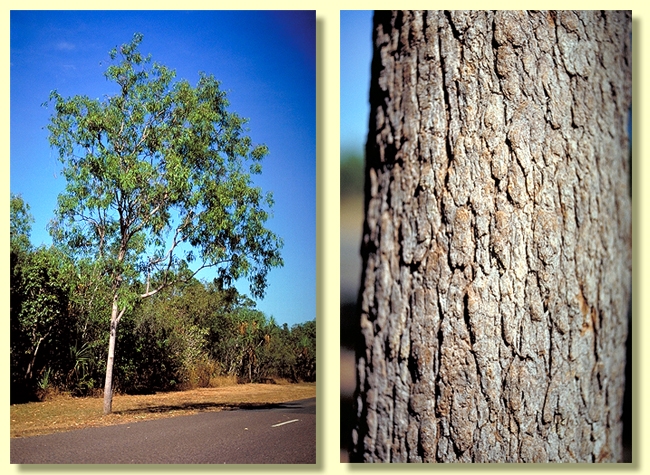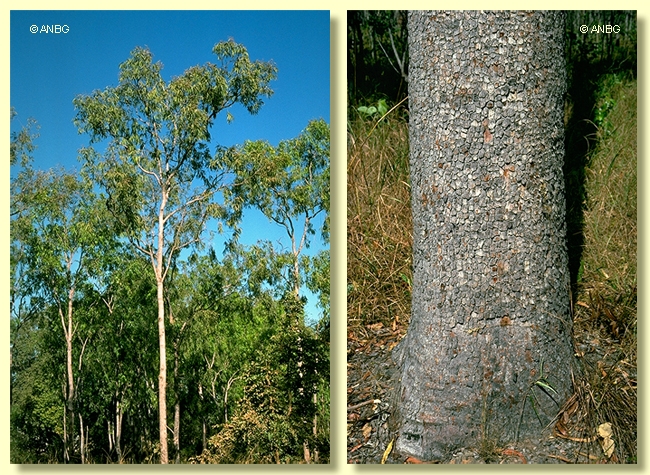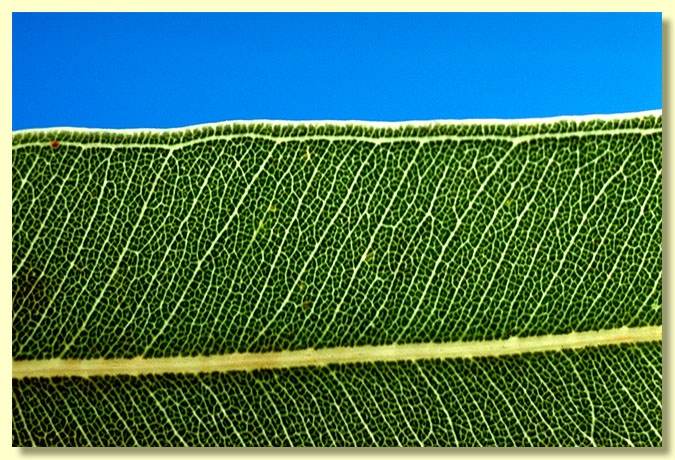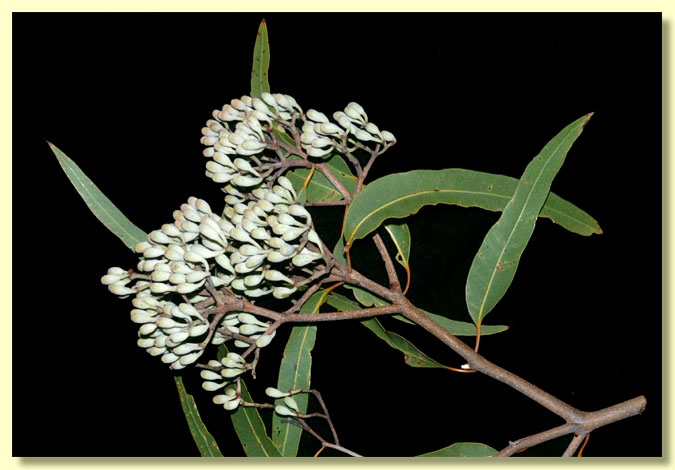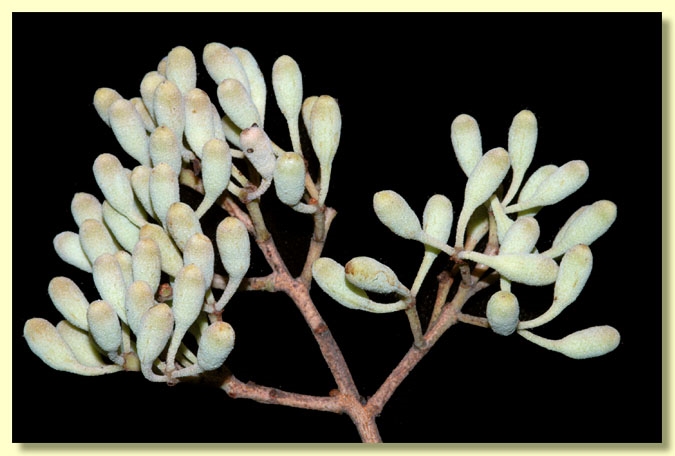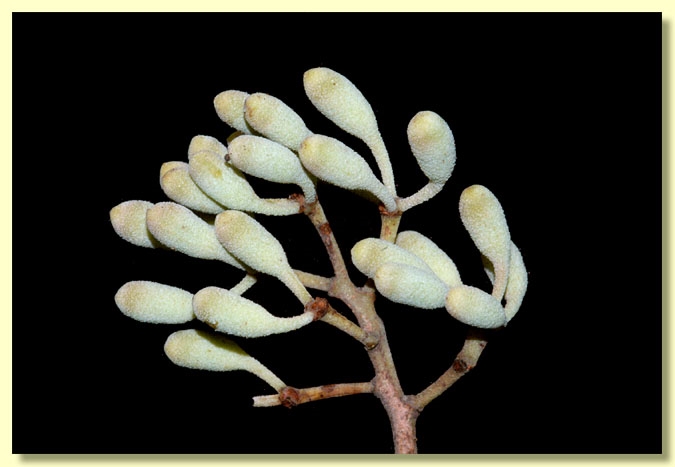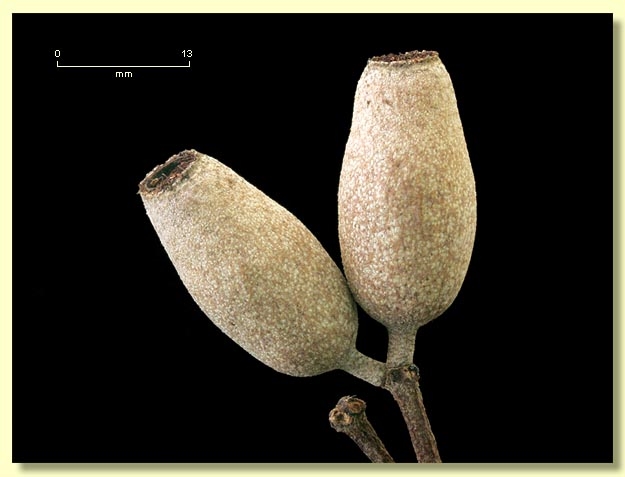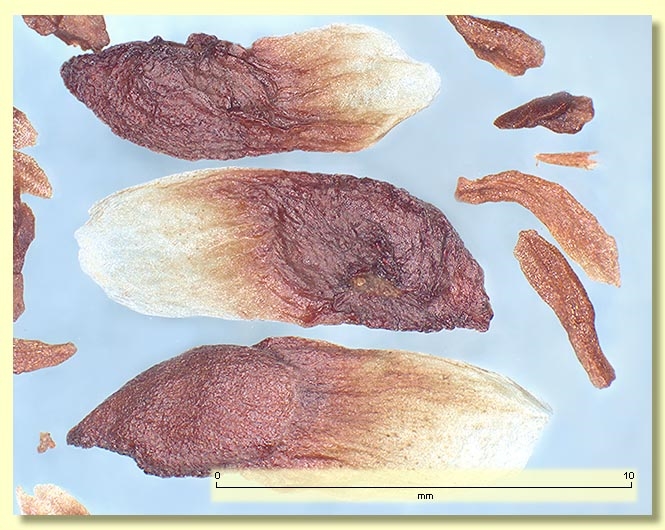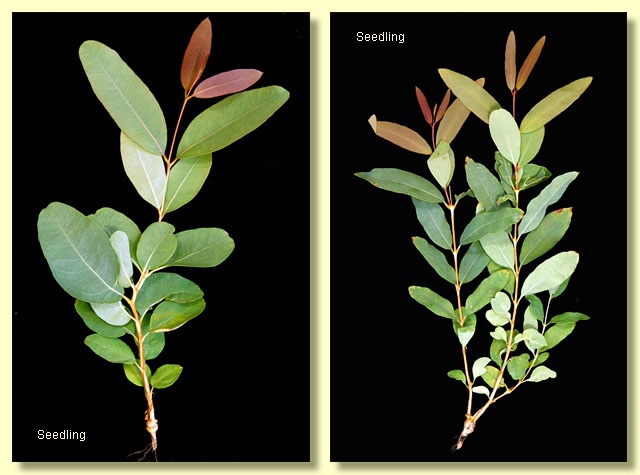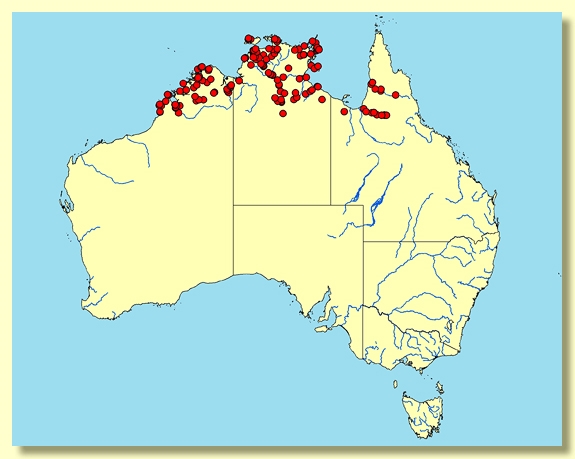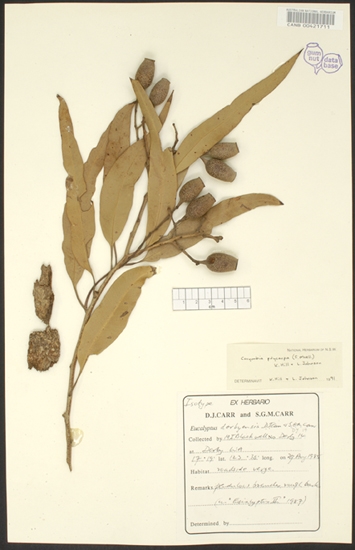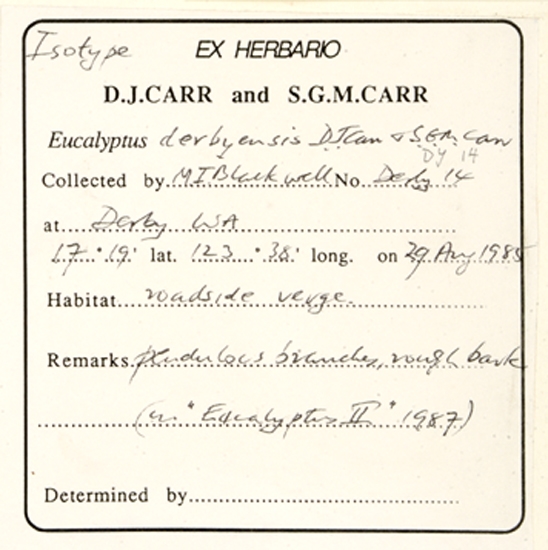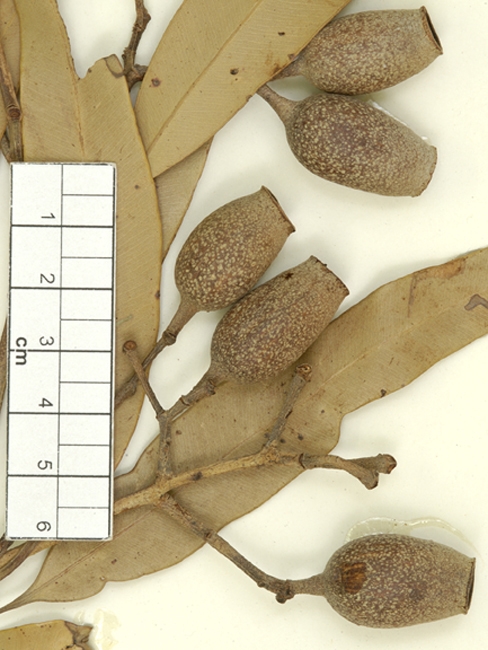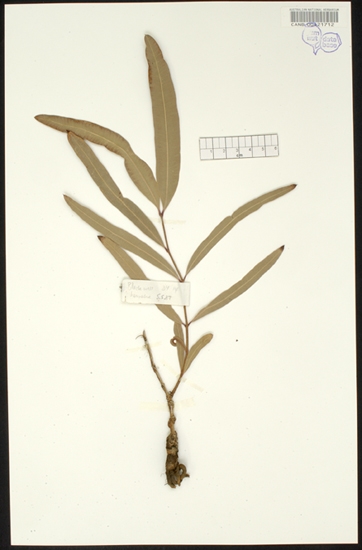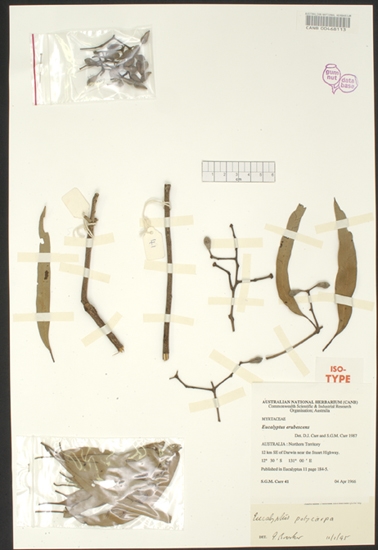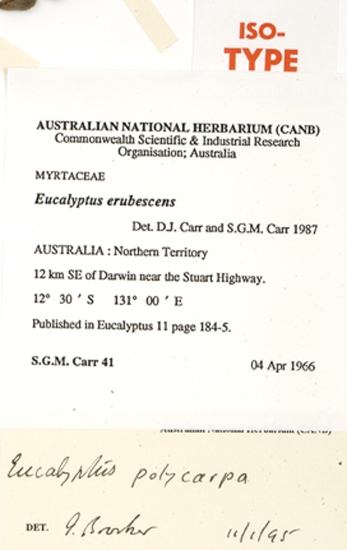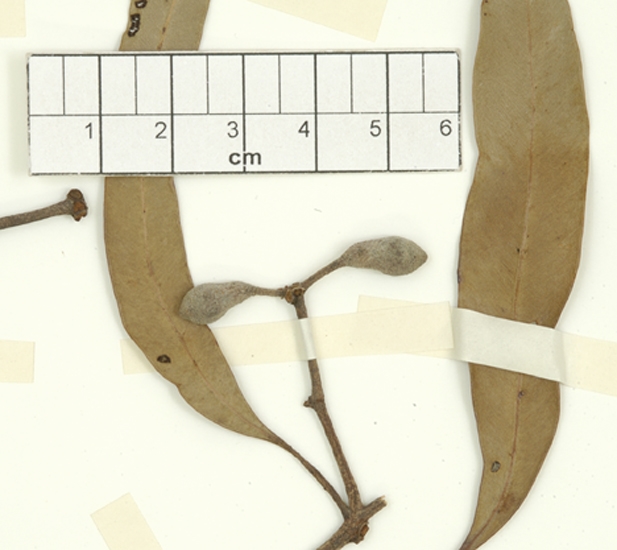Euclid - Online edition
Corymbia polycarpa
Corymbia | Rufaria
Eucalyptus derbyensis D.J.Carr & S.G.M.Carr, Eucalyptus 2: 189 (1987). T: Western Australia: street verge in Derby, 29 Aug. 1985, M.I.Blackwell, Derby 14 ; holo: PERTH; iso: CANB, DNA, MEL.
Tree to 20 m tall. Forming a lignotuber.
Bark rough to the small branches, tessellated, grey and grey-brown over red-brown.
Branchlets lack oil glands in the pith.
Juvenile growth (coppice or field seedlings to 50 cm): stems rounded to square in cross-section, smooth; juvenile leaves always petiolate, opposite for ca 25 nodes, elliptic to lanceolate, to 25 cm long, 1–4 cm wide, base tapering to petiole, apex pointed, green, smooth.
Adult leaves alternate, petioles 0.7–2.8 cm long; blade lanceolate to falcate, 7.8–20.8 cm long, 1–3.8 cm wide, base tapering to petiole, margin entire, apex pointed, discolorous, usually ± glossy, green, smooth, side-veins greater than 45° to midrib, reticulation very dense, intramarginal vein present and close to margin, oil glands usually visible, island, one per areole.
Inflorescence terminal compound, peduncles 0.5–2.5 cm long; buds 7 or 9 per umbel, pedicels 0.2–1.2 cm long. Mature buds obovoid to narrowly pyriform, 0.9–1.4 cm long, 0.5–0.8 cm wide, scurfy (whitish scaly surface due to fragmenting rubber cuticle), scar absent (both opercula shed together at flowering), operculum shallowly rounded to conical, stamens inflexed, all fertile, anthers oblong, dorsifixed, versatile, dehiscing by longitudinal slits, style long and straight, stigma blunt and long-papillose, locules 4, the placentae each with ca 5 ± indistinct vertical ovule rows. Flowers creamy white to pale yellow.
Fruit pedicellate (pedicels 0.2–1.1 cm long), elongated barrel-shaped, slightly tapering distally or, less often, slightly constricted below the orifice, 1.5–3.5 cm long, 0.8–1.6 cm wide, longer than wide (mostly 1.6–2.1 times as long as wide, rarely more), ± smooth, disc descending vertically, valves 4, enclosed.
Seeds brown, 8–13 mm long, ellipsoidal with terminal wing, hilum subterminal.
Cultivated seedlings (measured at ca node 10): cotyledons reniform; stems rounded in cross-section, setose with short bristle-glands for up to 8 nodes then smooth; leaves always petiolate, opposite for at least 16 nodes, narrowly oblong to elliptical or lanceolate, 6.5–10(17) cm long, 0.8–3.7 cm wide, base tapering to petiole, dull or slightly glossy, green, only sparsely setose on lower leaves, smooth after ca 6–8 pairs.
Flowering has been recorded in April, May, June, July and August.
A bloodwood tree widespread and common from Broome and Derby through the central and northern Kimberley region of Western Australia extending east through Kununurra, across the Top End of the Northern Territory and adjacent islands, around the Gulf of Carpentaria and on some islands therein, to about the Mitchell River on southern Cape York Peninsula, Queensland. Preferred habitat is areas of sandy or silty alluvium, sometimes on cracking clays, sometimes on sandstone, but generally near creeks, in depressions or on floodplains. Corymbia polycarpa is a fully rough-barked tree with a crown of discolorous leaves, whitish very scurfy slender buds, and elongated barrel-shaped fruit 1.6–2.1 times as long as wide, sometimes slightly contracted to form a neck or, more commonly, not at all contracted.
In the Kimberley region and in the Northern Territory C. polycarpa is a distinctive species because of the above combination of characters and habitat. The fruit shape in particular is very helpful. In the Queensland part of the species range C. polycarpa can be confused with C. novoguinensis and C. clarksoniana.
The widespread C. clarksoniana differs from C. polycarpa in having urceolate fruit, not narrowly barrel-shaped, and less scurfy buds. The more restricted C. novoguinensis is found from Weipa northwards on Cape York Peninsula, as well as on the islands of Torres Strait, Papua New Guinea and West Papua, and differs from C. polycarpa in having more plump buds usually on longer pedicels (though there is some overlap in these measurements), and urn- to barrel-shaped fruit shorter and fatter than those of C. polycarpa. Trees morphologically intermediate between C. novoguinensis and C. polycarpa are found south from Weipa towards the Mitchell River on the western side of Cape York Peninsula. Further to the south in the Einasleigh, Greenvale and The Lynd area of northern Queensland, C. ligans, another species related to C. polycarpa, was described by Hill & Johnson (1995). C. ligans looks like a depauperate form of C. polycarpa, having predominantly narrower crown leaves, smaller scurfy buds, and smaller, ± barrel-shaped fruit (though with some overlap in dimensions). C. ligans is a poorly collected species and time will tell if it is worthy of specific distinction.
This table shows that fruit shape rather than dimensions is the best guide to these four related species:
Species
Fruit shape
Fruit length cm
Fruit width cm
Length: width ratio
clarksoniana
urn-shaped
1.2–2.5
0.9–1.6
1.1 to 1.8
ligans
elongated barrel-shaped, tapering distally, sometimes slightly constricted below the rim
1.1–2
0.7–1.2
1.4 to 1.9
novoguinensis
urn-shaped to barrel-shaped, contracted slightly in upper part with the rim slightly flared
1.7–2.4(3)
1.1–1.5(2)
1.3 to 1.7
polycarpa
elongated barrel-shaped
1.5–3.5
0.8–1.6
1.6 to 2.1
MORE ABOUT CORYMBIA
MORE ABOUT RED BLOODWOODS
Corymbia polycarpa: Greek poly, many and carpos fruit, alluding to the conspicuous clusters of fruit in this species.

